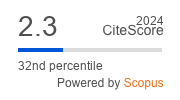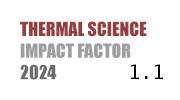THERMAL SCIENCE
International Scientific Journal
AN EXPERIMENTAL STUDY OF FLAME SPREAD OVER THE BAMBOO SLAB OF DIFFERENT INCLINATION ANGLES AND THICKNESSES
ABSTRACT
Bamboo as a new type of building material, is an alternative raw material for wood and wood-based composites, but its burning could result in fire disaster. The aim of this study was to examine the surface flame spread behavior over the inclined bamboo slab. A series of experiments were conducted using bamboo slabs with thicknesses of 2.5 mm, 3.5 mm, and 5 mm. The flame morphology, flame spread rate, and mass loss rate vs. the inclination angle and thickness were measured and physically explained. The results show that the flame spread rate increases with increasing inclination angle of slab and decreases with increasing slab thickness. The mass loss rate is positively affected by the inclination angle, while it is little influenced by the slab thickness. The available flame spread models of thermally thin and thick solid materials underestimate the measured flame spread rates over bamboo slabs. But the thermally thick solid flame spread model is comparatively suitable for the bamboo conditions in this paper. The findings of this study can support the fire permanence design of bamboo structural buildings.
KEYWORDS
PAPER SUBMITTED: 2024-02-24
PAPER REVISED: 2024-05-18
PAPER ACCEPTED: 2024-05-22
PUBLISHED ONLINE: 2024-12-07
THERMAL SCIENCE YEAR
2025, VOLUME
29, ISSUE
Issue 3, PAGES [2343 - 2355]
- Qiu, Z. Y., Fan, H. L., Laminated Bamboo Materials for Plated Building Structures, Journal of Building Engineering, 61 (2022), 105239
- Hong, C. K., et al., Review of Connections for Engineered Bamboo Structures, Journal of Building Engineering, 30 (2020), 101324
- Verma, C. S., et al., Comparative Study of Mechanical Properties of Bamboo Laminae and Their Laminates with Woods and Wood Based Composites, Composites Part B: Eng., 60 (2014), Apr., pp. 523-530
- Kelkar, B. U., et al., Structural Bamboo Composites: A Review of Processing, Factors Affecting Properties and Recent Advances, Advances in Bamboo Science, 3 (2023), 100026
- Ayani, M. B., et al., Downward Flame Spread Over PMMA Sheets in Quiescent Air: Experimental and Theoretical Studies, Fire Safety Journal, 41 (2006), 2, pp. 164-169
- Bhattacharjee, S., et al., Correlating the Burning Rate with Spread Rate for Downward Flame Spread over PMMA, Proceedings, 10th US Nat. Combustion Meet., Uni. of Maryland, College Park, Md., USA, 2017
- Carmignani, L., Bhattacharjee, S., Burn Angle and Its Implications on Flame Spread Rate, Mass Burning Rate, and Fuel Temperature for Downward Flame Spread Over Thin PMMA, Combustion Science and Technology, 192 (2019), 8, pp. 1617-1632
- Zhao, K., et al., Experimental Study on Flame Spread Over Inclined PMMA and PE Slabs, Key Engineering Materials, 775 (2018), Aug., pp. 390-394
- Gollner, M. J., et al., Experimental Study of Upward Flame Spread of an Inclined Fuel Surface, Proceedings of the Combustion Institute, 34 (2013), 2, pp. 2531-2538
- Chen, P., et al., Behavior of Flame Spread Downward Over Thick Wood Sheets and Heat Transfer Analysis, Journal of Fire Sciences, 25 (2016), 1, pp. 5-21
- Hong, T.-K., Park, S.-H., Influences of the Presence of Char Layer on Flame Spreads Over Wood with Different Thermal Thickness, J. of Mechanical Science and Technology, 37 (2023), May, pp. 3841-3848
- Zhang, Y., et al., Prediction of the Critical Condition for Flame Acceleration Over Wood Surface with Different Sample Orientations, Combustion and Flame, 159 (2012), 9, pp. 2999-3002
- Zhang, Y., et al., The Deceleration Mechanism and the Critical Extinction Angle of Downward Flame Spread Over Inclined Cellulosic Solids, Applied Thermal Engineering, 124 (2017), Sept., pp. 185-190
- Wang, Q. S., et al., Flame Spread on Inclined Wood Surfaces: Influence of External Heat Flux and Ambient Oxygen Concentration, Combustion Science and Technology, 190 (2017), 1, pp. 97-113
- Shah, D. U., et al., Thermal Conductivity of Engineered Bamboo Composites, Journal of Materials Science, 51 (2016), Dec., pp. 2991-3002
- Rangwala, A. S., et al., Upward Flame Spread on a Vertically Oriented Fuel Surface: The Effect of Finite Width, Proceedings of the Combustion Institute, 31 (2007), 2, pp. 2607-2615
- Zhang, G. H., et al., Deceleration Mechanism of Downward Flame Spreading Over Inclined Solid Surface Based on FireFOAM, Case Studies in Thermal Engineering, 34 (2022), 102066
- Mačiulaitis, R., et al., Research of Natural Wood Combustion and Charring Processes, Journal of Civil Engineering and Management, 18 (2012), 5, pp. 631-641
- De Ris, J. N., Spread of a Laminar Diffusion Flame, Proceedings of the Combustion Institute, 12 (1969), 1, pp. 241-245
- Quintiere, J. G., Fundamentals of Fire Phenomena, John Wiley & Sons, New York, USA, 2006
- Quintiere, J. G., The Effects of Angular Orientation on Flame Spread Over Thin Materials, Fire Safety. Journal., 36 (2001), 3, pp. 291-312
- Morrisset, D., et al., Characterization of Flame Spread Over PMMA Using a Temperature Reconstruction Method, Combustion Science and Technology, 195 (2023), 14, pp. 3557-3570
- Saito, K., et al., Upward Turbulent Flame Spread, Fire Safety Science, 1 (1986), Jan., pp. 75-86
- Huang, P. X., et al., Specific Heat Capacity Measurement of Phyllostachys Edulis (Moso Bamboo) by Differential Scanning Calorimetry, Construction and Building Materials, 125 (2016), Oct., pp. 821-831
- Huang, P. X., et al., Heat and Moisture Transfer Behaviour in Phyllostachys Edulis (Moso Bamboo) Based Panels, Construction and Building Materials, 166 (2018), Mar., pp. 35-49
- Solarte, A., et al., Understanding Fire Growth for Performance Based Design of Bamboo Structures, Fire Safety Journal, 120 (2021), 103057

